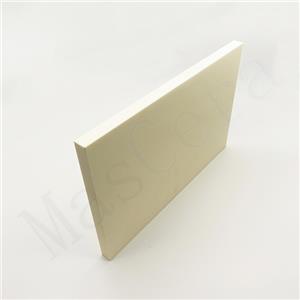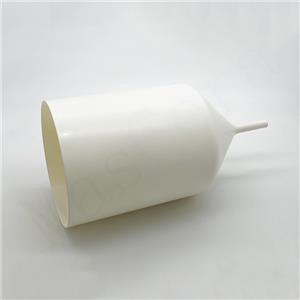Common Sintering Processes for Silicon Carbide Ceramics
1.Reaction Sintering
The process of reaction sintering silicon carbide begins with the mixing of a carbon source and silicon carbide powder. After forming the mixture through slip casting, dry pressing, or cold isostatic pressing, a green body is prepared. Subsequently, silicon infiltration reaction occurs by heating the green body to above 1500°C in a vacuum or inert atmosphere. Solid silicon melts into liquid silicon, permeating the green body through capillary action. The chemical reaction between liquid silicon (or silicon vapor) and carbon in the body results in the in-situ formation of β-SiC, which binds with the existing SiC particles, forming reaction-sintered silicon carbide ceramic material. Key factors influencing the performance of reaction-sintered silicon carbide include the size and type of carbon source, particle size of silicon carbide raw materials, porosity of the green body, sintering temperature, and holding time. The advantages of reaction sintering include low sintering temperature, low production cost, and high material densification, making it particularly suitable for the fabrication of large-sized and complex-shaped structural components. Typical applications include high-temperature kiln materials, radiation tubes, heat exchangers, and desulfurization nozzles.
2. Pressureless Sintering
Pressureless sintering of silicon carbide occurs without applying external pressure. Suitable sintering aids are added, and dense sintering is achieved between 2000°C and 2150°C. The process can be categorized into solid-phase sintering and liquid-phase sintering based on the form of the sintering aid. Solid-phase sintering employs B and C as sintering aids, with other options including B4C + C, BN + C, BP + C, AlB2 + C. Solid-phase sintering can achieve high density (3.10 - 3.15 g/cm³) without intergranular glassy phase, exhibiting excellent high-temperature mechanical properties with a usage temperature up to 1600°C. However, if the sintering temperature is too high, it may result in large grain size and reduced bending strength. Liquid-phase sintering uses certain amounts of multicomponent low eutectic oxides as sintering aids, achieving densification of SiC at lower temperatures. The process results in fine and uniform equiaxed grains, and the introduction of liquid phase weakens the interface binding, leading to complete transgranular fracture and significantly improved strength and toughness. Pressureless sintering of silicon carbide is a mature technology with advantages such as the ability to use various shaping processes, low production cost, and the ability to achieve high strength and toughness with the appropriate additives. Typical industrial products include wear-resistant and corrosion-resistant sealing rings, sliding bearings, among others.
3. Hot-Pressing Sintering
Hot-pressing sintering involves filling dried silicon carbide powder into a high-strength graphite mold. Simultaneously applying axial pressure and heating under controlled pressure-temperature-time conditions results in the sintering and shaping of silicon carbide. The process benefits from the simultaneous application of heat and pressure, where the powder is in a thermoplastic state, facilitating particle contact, diffusion, and flow mass transfer processes. This method can produce silicon carbide ceramics with fine grains, high relative density, and excellent mechanical properties at lower sintering temperatures and shorter sintering times. However, the complexity of equipment and processes, high requirements for mold materials, limited applicability to simple-shaped parts, low production efficiency, and high production costs are notable drawbacks. As a result, this method is mainly suitable for special applications.
4. Hot Isostatic Pressing (HIP) Sintering
HIP involves subjecting materials (powders, green bodies, or sintered bodies) to balanced pressure during the heating process, utilizing inert gases such as argon or nitrogen as pressure transmission media. The combination of high temperature and high pressure promotes densification. The HIP technology can produce fully homogeneous, microstructurally uniform, fine-grained, and fully dense materials at lower sintering temperatures and shorter times. It is suitable for preparing complex-shaped products, especially when low powder requirements are essential for nanoparticle ceramics preparation. The technology allows precise control of the final dimensions of the product, requiring minimal post-processing or even enabling direct use without additional processing. However, HIP sintering is characterized by high barriers to encapsulation technology, high investment and operating costs, limiting its widespread application.
XIAMEN MASCERA TECHNOLOGY CO., LTD. is a reputable and reliable supplier specializing in manufacturing and sales of technical ceramic parts. We provide custom production and high precision machining for a wide series of high performance ceramic materials including alumina ceramic, zirconia ceramic, silicon nitride, silicon carbide, boron nitride, aluminum nitride and machinable glass ceramic. Currently, our ceramic parts can be found in many industries like mechanical, chemical, medical, semiconductor, vehicle, electronic, metallurgy etc. Our mission is to provide the best quality ceramic parts for global users and it is a big pleasure to see our ceramic parts work efficiently in customers' specific applications. We can cooperate on both prototype and mass production, welcome to contact us if you have demands




